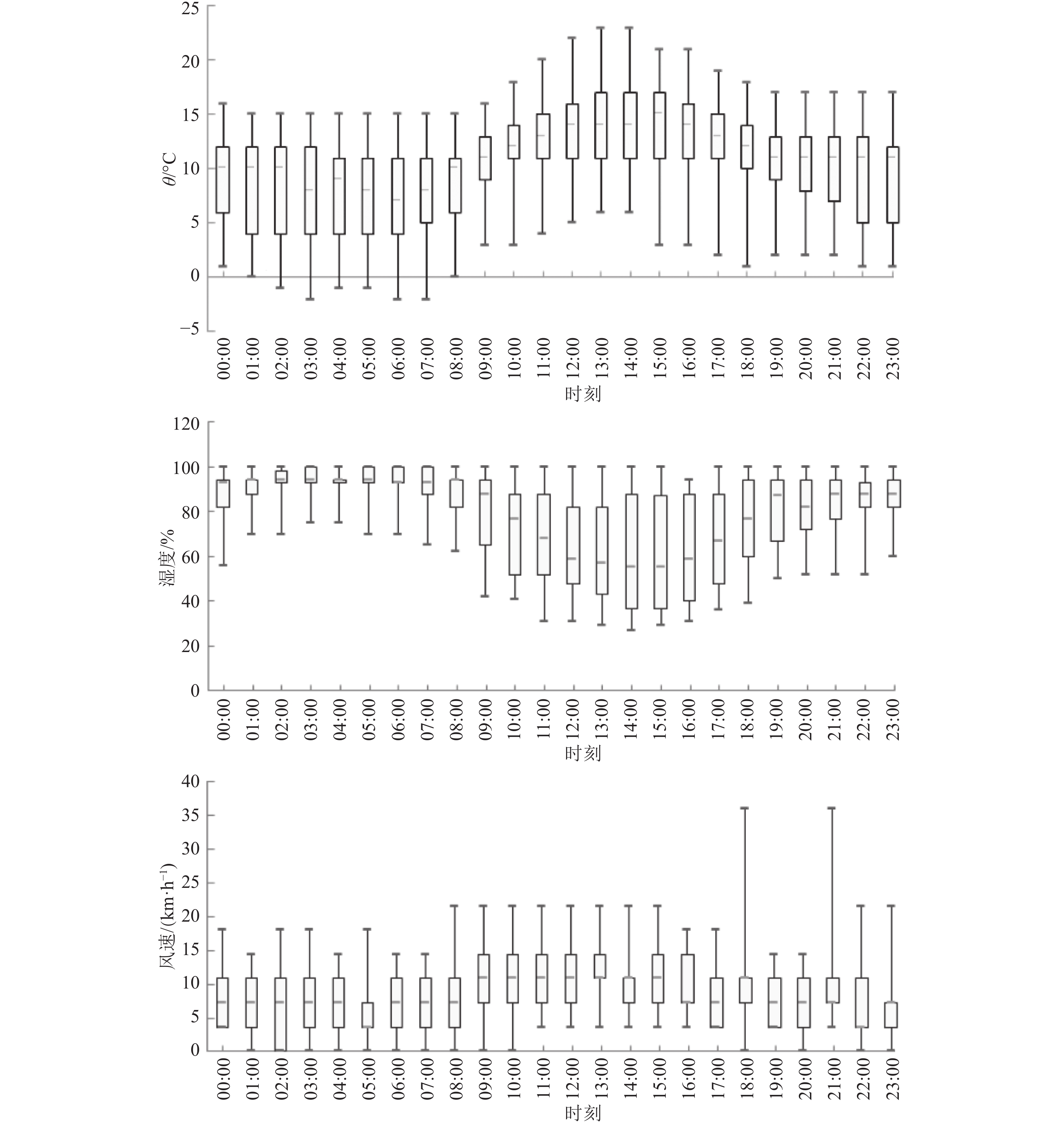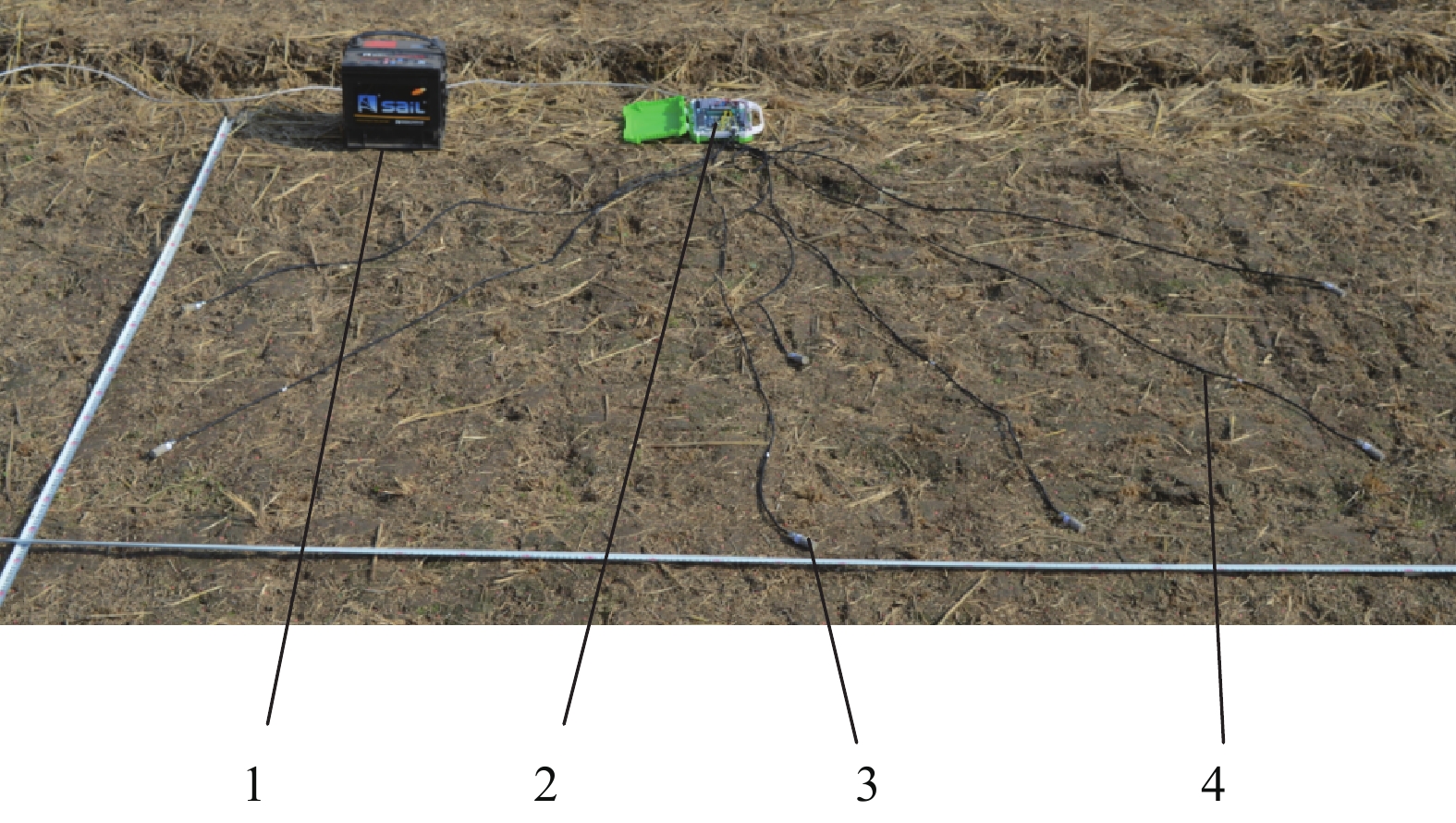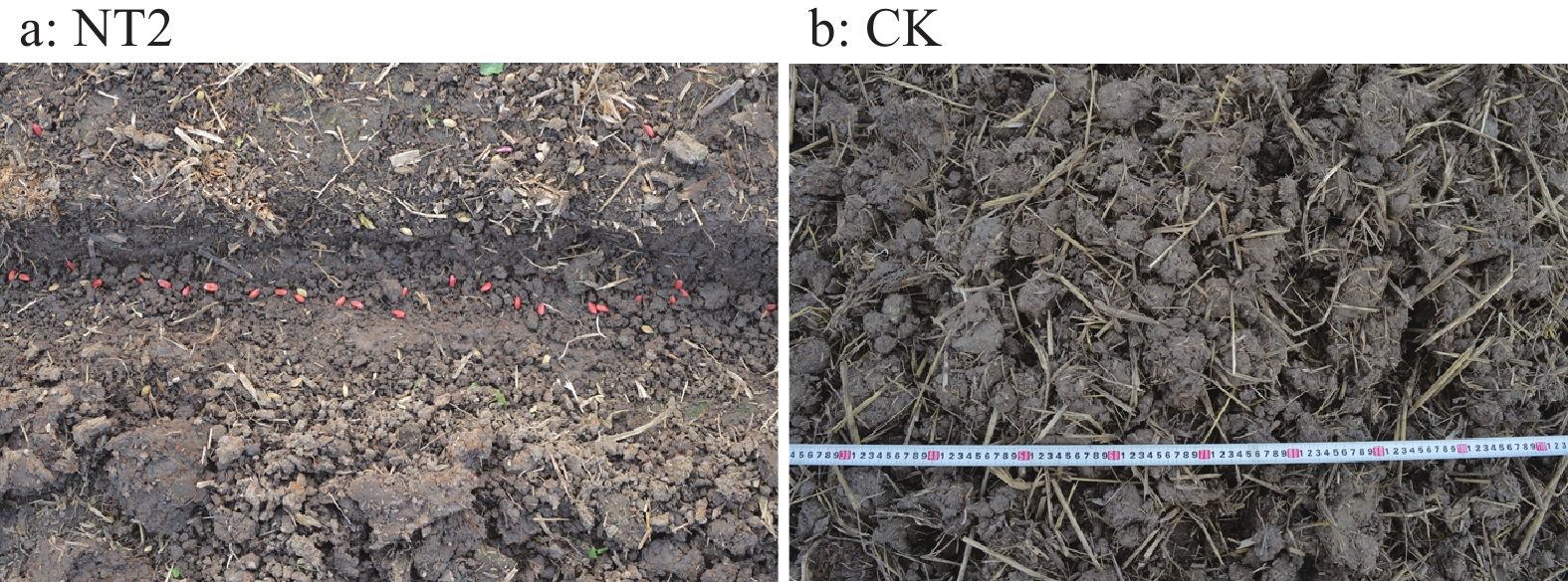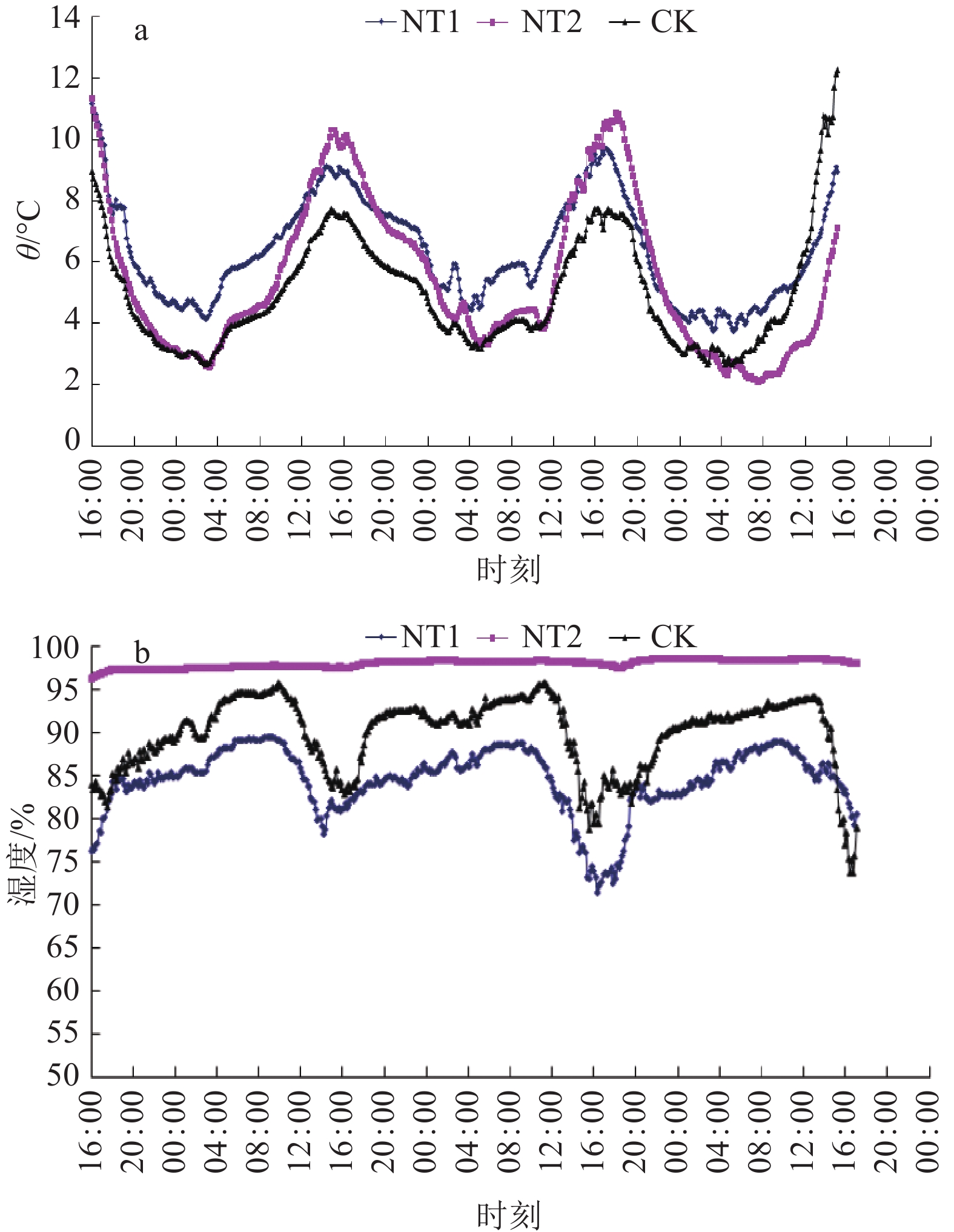Micro-climate characteristics and seedling qualities in seed-zone of post-paddy wheat field under different tillage and seeding modes
-
摘要:目的
评价不同耕作、播种模式的区域适应性,为稻麦轮作区耕作、播种技术的优化及相关精密播种机具的设计提供理论依据,确保稻茬麦的优质高产。
方法利用种子区微气候测试仪监测免耕露播覆草(NT1),免耕条播(NT2)和常规旋耕盖籽(CK)3种模式的稻茬麦种子区微气候条件及其对种子萌发及立苗的影响。
结果田间试验表明,3种模式的种子区微气候差异显著。NT1条件下种子区微气候相对稳定,CK条件下由于旋耕形成大土块,大土块垒结后形成的大尺度孔隙空间使种子区微气候变化较大,不利于保墒。NT2条件下的种子区微气候比NT1和CK相对稳定且温湿度条件更适合种子的萌发。NT1、NT2和CK条件下出苗率分别为 58.39%、71.81%和61.80%。
结论不同耕作和播种模式的种子区微气候条件及种子萌发立苗效果差异显著,使用种子区微气候测试仪能够快速准确评价稻茬麦耕作、播种模式的区域适应性。良好的耕种措施、种床环境以及种土接触是保证小麦出苗生长的关键。
Abstract:ObjectiveTo evaluate the regional applicability of different tillage and seeding modes, provide a theoritical basis for cultivating in rice-wheat rotation area, optimizing sowing technique and designing related precision seeders, and guarantee high quality and yield of post-paddy wheat.
MethodA seed-zone micro-climate tester was applied to continuously monitor the micro-climate conditions, seed germination and seedling establishment under three seeding modes, including no-till mulching (NT1), no-till drill (NT2) and rotary-tilling broadcasting (CK).
ResultThe field experiment showed that the seed-zone micro-climates under three seeding modes varied significantly. Seed-zone micro-climate under NT1 mode remained relatively stable. Large soil clods formed under CK mode, and led to a large change of micro-climate in seed-zone and made it difficult to conserve soil moisture. NT2 created the most stable seed-zone micro-climate, providing the most suitable temperature and humidity for seed germination. The germination rates under NT1, NT2 and CK modes were 58.39%, 71.81% and 61.80% respectively.
ConclusionDifferent tillage and seeding modes significantly influence seed-zone micro-climate, seed germination and seedling establishment. The proposed seed-zone micro-climate tester is suitable for quickly and accurately evaluating the regional applicability of tillage and seeding modes for past-paddy wheat. Excellent tillage procedures, good seedbed environment and large contact area between seed and soil are the key factors of wheat growth.
-
Keywords:
- post-paddy wheat /
- seeding mode /
- seed-zone /
- micro-climate /
- seed germination /
- seedling establishment
-
-
表 1 不同耕作和播种模式下的日平均温度和湿度1)
Table 1 Daily mean temperature and relative humidity under different tillage and seeding modes
处理 θ/℃ 湿度/% NT1 6.160a 84.459c NT2 5.516ab 97.922a CK 5.089b 89.986b 1)同列数据后凡具有一个相同小写字母者,表示处理间差异不显著(P>0.05,Duncan’s 法) 表 2 不同耕作和播种方式对小麦出苗整齐度和立苗率的影响
Table 2 Effects of different tillage and seeding modes on seedling rates and uniformities of wheat
处理 立苗率1)/% 变异系数 不同苗龄幼苗整齐度/% 3叶 2叶1心 2叶 1叶1心 1叶 NT1 58.39b 0.085 6 35.29 35.01 14.51 11.85 3.34 NT2 71.81a 0.109 5 40.38 39.59 13.04 5.29 1.70 CK 61.80b 0.114 2 17.85 28.12 32.04 15.11 6.88 1)同列数据后凡具有一个相同小写字母者,表示处理间差异不显著(P>0.05,Duncan’s 法) -
[1] 赵俊晔, 于振文. 我国小麦生产现状与发展小麦生产能力的思考[J]. 农业现代化研究, 2005, 26(5): 344-348. [2] 卢布, 丁斌, 吕修涛, 等. 中国小麦优势区域布局规划研究[J]. 中国农业资源与区划, 2010, 31(2): 6-12. [3] 赵广才. 中国小麦种植区域的生态特点[J]. 麦类作物学报, 2010, 30(4): 100-102. [4] 王小燕, 高春保, 熊勤学, 等. 江汉平原小麦生产面临的挑战及对策[J]. 作物杂志, 2013(3): 17-20. [5] 杨四军, 顾克军, 张恒敢, 等. 影响稻茬麦出苗的关键因子与应对措施[J]. 江苏农业科学, 2011, 39(5): 89-91. [6] 李文阳, 时侠清, 徐建军, 等. 种子催芽对晚播小麦幼苗特性及产量的影响[J]. 安徽农业科学, 2013, 41(4): 1488. [7] 汤永禄, 程少兰, 李朝苏, 等. 稻茬麦半旋高效播种技术[J]. 四川农业科技, 2010(9): 20-21. [8] 汤永禄, 黄钢, 袁礼勋. 稻茬麦精量露播稻草覆盖高效栽培技术[J]. 作物杂志, 2000(3): 22-24. [9] 汤永禄, 李朝苏, 吴春, 等. 播种方式对丘陵旱地套作小麦立苗质量、产量及效益的影响[J]. 中国农业科学, 2013, 46(24): 5089-5097. [10] 张银平, 杜瑞成, 刁培松, 等. 机械化生态沃土耕作模式提高土壤质量及作物产量[J]. 农业工程学报, 2015, 31(7): 33-38. [11] 聂良鹏, 郭利伟, 牛海燕, 等. 轮耕对小麦-玉米两熟农田耕层构造及作物产量与品质的影响[J]. 作物学报, 2015, 41(3): 468-478. [12] 王玉玲, 李军, 柏炜霞. 轮耕体系对黄土台塬麦玉轮作土壤生产性能的影响[J]. 农业工程学报, 2015(1): 107-116. [13] 王树林, 祁虹, 王燕, 等. 麦棉套作模式下播种方式与播量对小麦灌浆特性及产量性状的影响[J]. 麦类作物学报, 2016, 36(3): 355-361. [14] LI Q Q, ZHOU X B, CHEN Y H, et al. Grain yield and quality of winter wheat in different planting patterns under deficit irrigation regimes[J]. Plant Soil Environ, 2010, 56(10): 482-487.
[15] 陈留根, 刘红江, 沈明星, 等. 不同播种方式对小麦产量形成的影响[J]. 江苏农业学报, 2015, 33(4): 786-791. [16] 赵红梅, 杨艳君, 李洪燕, 等. 不同保墒耕作与播种方式对旱地小麦农艺性状及产量的影响[J]. 灌溉排水学报, 2016, 35(5): 74-78. [17] 郑亭, 樊高琼, 王秀芳, 等. 耕作方式、播深及覆土对机播套作小麦麦苗素质的影响[J]. 农业工程学报, 2011, 27(5): 164-168. [18] 樊高琼, 郑亭, 陈溢, 等. 耕作方式、播深及覆土对机播套作小麦群体质量和产量的影响[J]. 农业工程学报, 2011, 27(S2): 20-25. [19] FORCELLA F, ARNOLD R L B, SANCHEZ R, et al. Modeling seedling emergence[J]. Field Crop Res, 2000, 67(2): 123-139.
[20] WEITBRECHT K, MÜLLER K, LEUBNERMETZGER G. First off the mark: Early seed germination[J]. J Exp Bot, 2011, 62(10): 3289-3309.
[21] 芮超杰, 丁启朔, 李毅念, 等. 基于单片机技术的露播种子区微气候评价[J]. 南京农业大学学报, 2016, 39(6): 1055-1061. [22] 陈信信, 丁启朔, 丁为民, 等. 基于虚拟植物技术的冬小麦根系3D构型测试与分析[J]. 中国农业科学, 2014, 47(8): 1481-1488. [23] 何井瑞, 陈之政, 韩必荣, 等. 播种方式和播量对小麦发育进程及产量构成的影响[J]. 上海农业科技, 2013(4): 47-49. [24] 程玉龙, 张礼钢, 翟步顺, 等. 稻茬田小麦种植不同耕作方式的比较与分析[J]. 中国农机化学报, 2014, 35(4): 69-72. [25] 李波, 魏亚凤, 季桦, 等. 稻草还田与不同耕作方式对小麦出苗以及产量的影响[J]. 中国农学通报, 2012, 28(24): 122-126. [26] 宋伟, 赵长星, 王月福, 等. 不同种植方式对花生田间小气候效应和产量的影响[J]. 生态学报, 2011, 31(23): 7188-7195. [27] 韩笑, 李永秀. 冬小麦冠层微气象特征及能量平衡的研究[J]. 安徽农业科学, 2010, 38(30): 17097-17100. [28] 许华森, 毕华兴, 高路博, 等. 晋西黄土区苹果+大豆间作系统小气候及其对作物生产力的影响[J]. 中国水土保持科学, 2014, 12(2): 9-15. [29] 李翠娜, 张雪芬, 李肖霞, 等. 农田小气候自动观测系统温度梯度观测设计[J]. 气象科技, 2015, 43(1): 8-14. [30] 陈素英, 张喜英, 裴冬, 等. 玉米秸秆覆盖对麦田土壤温度和土壤蒸发的影响[J]. 农业工程学报, 2005, 21(10): 171-173. [31] 关法春, 梁正伟. 稻草覆盖对羊草育苗床土水热条件及其出苗的影响[J]. 中国草地学报, 2008, 30(5): 47-53. [32] 韩宾, 李增嘉, 王芸, 等. 土壤耕作及秸秆还田对冬小麦生长状况及产量的影响[J]. 农业工程学报, 2007, 23(2): 48-53. [33] 张维城, 王绍中, 李春喜. 小麦植株分布状况对干物质积累和产量的影响[J]. 河南农业科学, 1995, 24(6): 1-6. [34] 雷金银, 吴发启, 王健, 等. 保护性耕作对土壤物理特性及玉米产量的影响[J]. 农业工程学报, 2008, 24(10): 40-45. [35] 程科, 李军, 毛红玲. 不同轮耕模式对黄土高原旱作麦田土壤物理性状的影响[J]. 中国农业科学, 2013, 46(18): 3800-3808. [36] 陈学文, 张晓平, 梁爱珍, 等. 耕作方式对黑土硬度和容重的影响[J]. 应用生态学报, 2012, 23(2): 439-444.




 下载:
下载:



